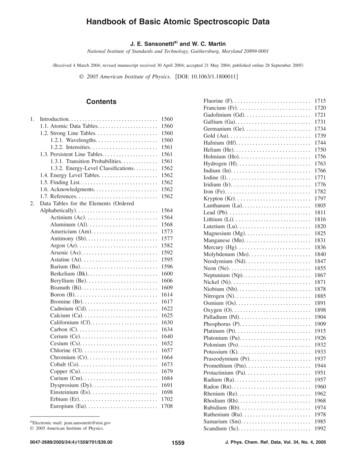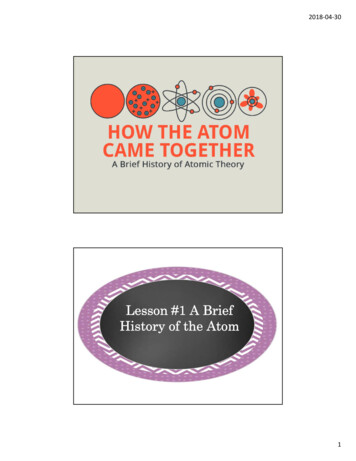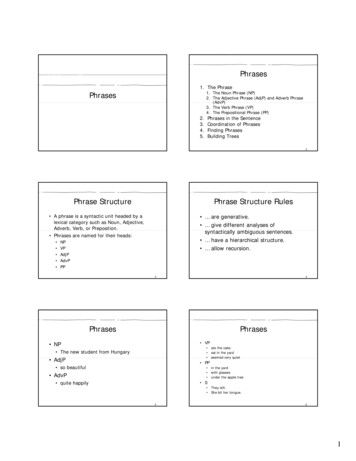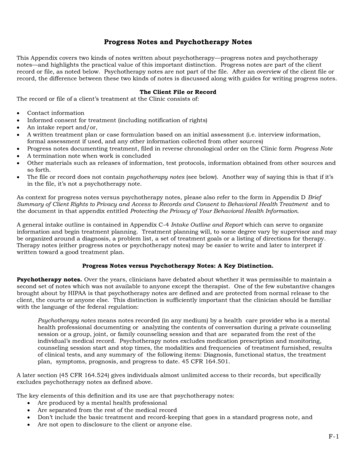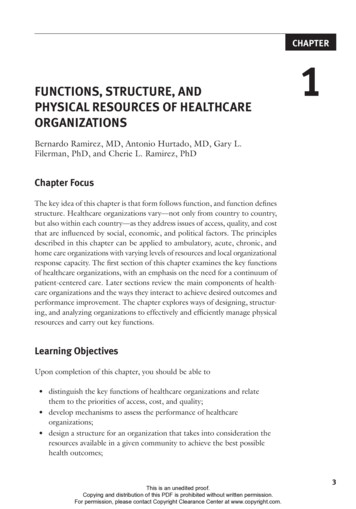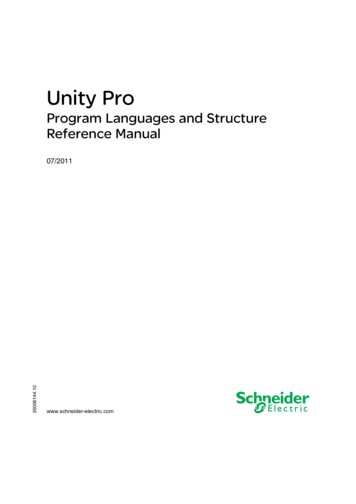
Transcription
Atomic StructureMODULE - 2Atomic Structure andChemical Bonding3ATOMIC STRUCTURENoteshemistry has been defined as the study of matter in terms of its structure, compositionCand the properties. As you are aware, matter is made up of atoms, and therefore anunderstanding of the structure of atom is very important. You have studied in your earlierclasses that the earliest concept of atom ( smallest indivisible part of matter ) was givenby ancient (600-400 BC) Indian and Greek philosophers. At that time there were noexperimental evidence. The origin of the concept of atom was based on their thoughts on‘What would happen if we continuously keep dividing matter’. John Dalton revived theconcept of atom in the beginning of nineteenth century in terms of his atomic theorywhich successfully explained the laws of chemical combination. Later experiments showedthat the atom is not indivisible but has an internal structure.In this lesson you will learn about the internal structure of an atom which will help you tounderstand the correlations between its structure and properties. You would learn aboutthese in the later lessons.ObjectivesAfter reading this lesson you will be able to : recognize the fundamental particles of atom; describe Rutherford’s experiment and explain its results; define electromagnetic radiation; list and define the characteristic parameters of electromagnetic radiation; discuss line spectrum of hydrogen; explain Bohr’s postulates and discuss his model; draw energy level diagram of hydrogen atom showing different series of lines in itsspectrum; explain wave particle duality of matter and radiation; formulate Heisenberg’s uncertainty principle;35
MODULE - 2Atomic Structure andChemical BondingNotesChemistry explain the need for quantum mechanical model; draw probability pictures of an electron in an atom; list quantum numbers and discuss their significance; draw the shapes of s, p and d orbitals; recognize nodal plane; explain Pauli’s exclusion principle; define Aufbau principle and explain Hund’s rule of maximum multiplicity.3.1 Fundamental Particles of AtomIn 1897 J.J. Thomson discovered electron as a constituent of atom. He determined thatan electron had a negative charge and had very little mass as compared to that of theatom. Since an atom was found to be electrically neutral it was inferred that some sourceof positive charge must be present in the atom. This soon led to the experimental discoveryof the proton, which is a positively charged subatomic particle. Proton was foundapproximately 1840 times heavier than an electron. Further’ experiments revealed thatthe atomic masses were more than that expected from the presence of just protons andelectrons in the atom. For example, the mass of helium atom was expected to be doublethat of hydrogen atom but was actually found to be almost four times the mass of hydrogenatom. This suggested the presence of neutral particles with mass comparable to that ofprotons in the atom. Sir James Chadwick discovered this neutral particle and called itneutron subsequently in 1932. Thus we may conclude that atoms are not indivisible butare made up of three fundamental particles whose characteristics are given in Table 3.1.Table 3.1 Fundamental particles of atom and their characteristicsParticleSymbolMass/ kgActual Charge / CRelative chargeElectrone9.109 389 10– 1.602 177 10–1Protonp1.672 623 10–271.602 177 10–19 1Neutronn1.674 928 10–2700–31–19Since atoms are made up of still smaller particles, they must have an internal structure. Inthe next section we shall take up some of the earlier ideas about the internal structure ofatom.Intext Question 3.11. Compare the mass of an electron with that of the proton.2. What is a fundamental particle?.36
Atomic Structure3. What is the name given to neutral particles in the atom?.MODULE - 2Atomic Structure andChemical Bonding3.2 Earlier ModelsOnce it was established that the atom is not indivisible, the scientists made attempts tounderstand the structure of the atom. A number of models have been proposed for theinternal structure of the atom. The first attempt to describe the structure of atom in termsof a model was made by J.J Thomson.Notes3.2.1 Thomson’s ModelOn the basis of his experiments on discharge tubes, Thomson proposed that atoms can beconsidered as a large positively charged body with a number of small negatively chargedelectrons scattered throughout it. This model (Fig.3.1) was called as plum pudding modelof the atom.Fig. 3.1 : A pictorial representation of Thomson’s plum-pudding modelThe electrons represent the plums in the pudding made of positive charge. It is sometimesalso called as watermelon model. In this, the juicy pulp of the watermelon represents thepositive charge and the seeds represent the electrons.J.J.Thomson(1856-1940)Won Nobel prize in Physics in 1906Ernest Rutherford(1871-1937)Won Nobel prize in Chemistry in 19083.2.2 Rutherford’s ExperimentErnest Rutherford performed an experiment called ‘Gold Foil Experiment’ or ‘α- rayscattering experiment’ to test the structure of an atom as proposed by Thomson. In thisexperiment a beam of fast moving alpha particles (positively charged helium ions) waspassed through a very thin foil of gold. He expected that the alpha particles would just passstraight through the gold foil and could be detected by a photographic plate. But, the actualresults of the experiment (Fig. 3.2) were quite surprising. It was observed that most of the -particles did pass straight through the foil but a number of particles were deflectedfrom their path. Some of these deflected slightly while a few deflected through largeangles and about 1 in 10,000 α- particles suffered a rebound37
MODULE - 2ChemistryAtomic Structure andChemical BondingNotesFig 3.2: Schematic representation of Rutherford’s -ray scattering experiment.Fig 3.3 : Schematic representationof Rutherford’s modelThese results led Rutherford to conclude that : the atom contained some dense and positively charged region located at the centerof the atom that he called as nucleus. all the positive charge of the atom and most of its mass was contained in the nucleus. the rest of the atom must be empty space which contains the much smaller andnegatively charged electrons (Fig. 3.3).The model proposed by Rutherford explained the observation in the -ray scatteringexperiments as shown below in Fig 3.4.Fig 3.4 : Explanation of the results of α- rayscattering experiment.Fig. 3.5 : Failure of Rutherford’smodelHowever, there was a problem with the Rutherford’s model. According to the Maxwell’stheory of electromagnetic radiation, a charged particle undergoing acceleration wouldcontinuously emit radiation and lose energy. Since the electron in the atom is also a chargedparticle and is under acceleration, it is expected to continuously lose energy. As aconsequence, the electron moving around the nucleus would approach the nucleus by aspiral path (Fig. 3.5) and the atom would collapse. However, since it does not happen wecan say that the Rutherford’s model failed to explain the stability of the atom.The next attempt to suggest a model for atom was made by Neils Bohr- a student ofRutherford. This model used the concept of quantisation of energy of electrons in theatom. Since this fact was suggested by line spectrum of hydrogen atom it is worthwhile tounderstand the meaning of a spectrum. For this we begin with the understanding of thenature of an electromagnetic radiation.38
Atomic StructureMODULE - 2Atomic Structure andChemical BondingIntext Question 3.21. List the three constituent particles of an atom.2. What was the aim of Rutherford’s α-rays scattering experiment?.Notes3. Briefly describe Rutherford’s model of an atom.4. On what basis was the Rutherford’s model rejected?.3.3 Electromagnetic RadiationsElectromagnetic radiation is a kind of energy, which is transmitted through space in theform of electric and magnetic fields. These do not require any medium to propagate.Visible light, radiant heat, radio waves, X-rays and gamma radiation are some of theexamples of electromagnetic radiations. According to the Maxwell’s theory, anelectromagnetic radiation can be visualised as oscillating electric and magnetic fields. Thesetravel as waves in the planes perpendicular to each other and also to the direction of propagation.(Fig. 3.6 (a) ). These radiations travel with the velocity of light (3.0 108 m agMCrest CrestAmplitude TroughTrough(a)39
MODULE - 2ChemistryAtomic Structure andChemical BondingZElectric fieldcomponentNotesDirection ofpropagationYXMagnetic fieldcomponent(b)(a)Fig. 3.6 : (a) An electromagnetic wave showing electric and magnetic fields travelling in planesperpendicular to each other and also to the direction of propagation (b) Characteristics ofelectromagnetic wave3.3.1 Characteristic Parameters of Electromagnetic RadiationsThe electromagnetic radiations are characterized by a number of parameters. These areAmplitude: This refers to the maximum height to which the wave oscillates. Itequals the height of the crests or depth of the troughs.Wavelength : It is the linear distance between two consecutive wave-crests orwave- troughs as shown in Fig. 3.6(b). It is represented by a Greek letter lambda ( and is expressed in terms of m, cm, nm or Angstrom (1Å 10-10 m).Frequency: It is defined as the number of wave crests or wave troughs that passthrough a given point per second. It is represented by a Greek letter nu ( ) and isexpressed in terms of s -1( second inverse or per second). It is also called asHz (Hertz).Wave number: It equals the number of waves per unit length. It is denoted as v(nu bar) and is equal to the reciprocal of the wavelength. The SI unit of v is m–1 (meterinverse). However, sometimes it is also expressed as cm–1 (centimeter inverse).v 1 Velocity: it is defined as the linear distance travelled by the wave in one second.The velocity in meters per second can be obtained by multiplying frequency in Hertz( s–1 ) with wavelength in meters.c The velocity of a radiation depends on the medium. In vacuum the velocity is equal to3.00 x 108 m s-1.c orv The electromagnetic radiations also show the characteristics of particles. These are calledas quanta. These quanta are actually bundles of energy. A quantum of visible light is40
Atomic Structurecalled a photon. The energy of the quantum ( or photon) is proportional to the frequencyof the radiation. The two are related asMODULE - 2Atomic Structure andChemical Bonding E hvThe energy of the quantum can also be related to the wavelength or wave number ascor E hcv the energy of photon can be readily calculated from these equations if we know thefrequency, wavelength or wave number.E hNotesExample 3.1 : A microwave radiation has a frequency of 12 gigahertz. Calculate theenergy of the photon corresponding to this radiation. ( h 6.626 10–34 J s and1 gigahertz 109 Hz.).Solution:The energy is given by the expression,Substituting the values we get,E hv10E 6.626 10–34 Js 1.2 10 s–1 7.95 10–24 JExample 3.2 : The green light has a wavelength of 535 nm. Calculate the energy of aphoton of green light.Solution: We know thatE hv hc (6.626 10 34 Js) (3.0 108 ms 1 ) 3.71 10 19 J 535 10 9 m3.3.2 Electromagnetic SpectrumDepending on their characteristics (wavelength , frequency and wave number)electromagnetic radiations are of many types and constitute what is called as anelectromagnetic spectrum. (Fig. 3.7) The part of the spectrum that we can see is calledvisible spectrum and is a very small part of the overall spectrum.Wavelength (in m)10–1010–910–8FARUVX-rays10191018Frequency (in ar IRNear e 650ENGAOR700DRE750Wavelength (in nm)Fig. 3.7: The electromagnetic spectrum41
MODULE - 2Atomic Structure andChemical BondingChemistryIntext Question 3.31. What is an electromagnetic radiation?.2. List any three characteristics of electromagnetic radiation.Notes.3. What is wave number? How is it related to wave length?.4. What is the difference between a ‘quantum’ and a ‘ photon’?.3.4 Line SpectrumYou know that when we pass a beam of sunlight through a prism we get a range ofcolours from violet to red (VIBGYOR) in the form of a spectrum (like rainbow). This iscalled a continuous spectrum because the wavelengths of the ligh
Won Nobel prize in Physics in 1906 Won Nobel prize in Chemistry in 1908 3.2.2 Rutherford’s Experiment Ernest Rutherford performed an experiment called ‘Gold Foil Experiment’ or ‘α- ray scattering experiment’ to test the structure of an atom as proposed by Thomson. In this experiment a beam of fast moving alpha particles (positively charged helium ions) was passed through a very thin .
